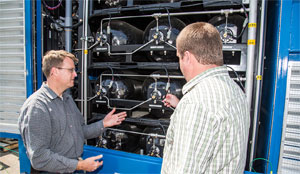Tom Escher wants to ride across San Francisco Bay on a quiet, fast boat with no emissions. And if the passengers get thirsty, they can drink the exhaust.
“Everyone is talking about reducing emissions by 20 percent, 40 percent or more,” said Escher, president of Red and White Fleet in San Francisco. “I thought, ‘Why not do away with emissions altogether?’”
That dream is moving a step closer to reality for Escher’s fleet. Red and White is partnering with Livermore, Calif.-based Sandia National Laboratories, part of the U.S. Department of Energy, to develop a high-speed, hydrogen-fuel-cell-powered passenger ferry and the world’s largest hydrogen refueling station. Other partners include the American Bureau of Shipping, U.S. Coast Guard and naval architect Elliott Bay Design Group of Seattle.
“We are involving so many stakeholders up front because if the feasibility study shows a ‘go’ we want to make sure the next phase has a rock-solid foundation,” said mechanical engineer Joe Pratt, who heads the Sandia project. “We hope that the feasibility study, regardless of the outcome, can be useful to others nationally and around the world who are looking at hydrogen fuel cell vessels as clean energy alternatives.”
The fuel cell would provide power for the ferry’s propulsion and auxiliary electrical systems, while the hydrogen refueling station would service the ferry, electric cars, buses and fleet vehicles, and other maritime vessels powered by fuel cells.
The project is called the San Francisco Bay Renewable Energy Electric vessel with Zero Emissions (SF-Breeze). The partners aim to design, build and operate a high-speed hydrogen fuel cell passenger ferry and the hydrogen refueling station.
“The concept of this project is an exciting step toward promoting alternative technology that will power our future,” said Ralph Borrmann, a spokesman for the Bay Area Air Quality Management District based in San Francisco. “Using fuel cells to power Bay Area ferries could produce dramatic reductions in fuel use, air pollution and greenhouse gases while continuing to provide safe, reliable service.”
The U.S. Department of Transportation’s Maritime Administration (MarAd) is providing $500,000 for a feasibility study to examine the technical, regulatory and economic aspects of the project. Maritime Administrator Paul “Chip” Jaenichen said this project encourages a shift toward lower-impact maritime fuels that may further green the waterborne link in our national transportation system.
“For the ferry, the big challenge is meeting the requirements of the user for boat performance that is commercially viable,” Pratt said. Achieving the top speed an operator needs from the boat — 35 knots in the Bay Area — is key, he noted. “The technical challenge is actually making a boat that holds passengers and doesn’t cost too much.
“If you are trying to achieve speed, boat weight is important,” Pratt added. “Fuel cells and hydrogen are heavier than existing diesel engines and fuel, so the question becomes can you build a boat powered by hydrogen fuel cells that is both large and fast enough? A preliminary conceptual study shows the answer is probably yes, but it will require a boat specially designed to accommodate hydrogen fuel and the fuel cell technology.”
Curt Leffers, project manager at Elliot Bay, said the biggest design challenge is dealing with the weight of the fuel cells, electrical propulsion equipment and hydrogen storage tanks. “Fast ferries are very weight-sensitive, and the weight of a fuel cell power plant along with its associate electrical components is heavier than diesel engines of equivalent power,” he said.
Bob Kunkel, president of Alternative Marine Technologies in Stamford, Conn., said in the U.S. designing a hydrogen fast ferry will require compliance with U.S. Coast Guard regulations. “Most manufacturers would have to get through CFR (Code of Federal Regulations) and the Coast Guard to determine if a fuel cell can be installed below deck. There are none for dealing with hydrogen below deck, where the fuel cell could be in a machinery space or near a fuel tank,” he said.
Coast Guard spokeswoman Lt. Janet Janaro stated via email that not until Red and White Fleet submits detailed plans would the Coast Guard be in a position to review the applicable regulations “to ensure an acceptable equivalency is established, or determine if a design basis agreement is needed.”
Depending on which subchapter of Title 46 of the Code of Federal Regulations the vessel is regulated under, the Coast Guard has an opportunity to accept an equivalent level of safety to an existing standard, Janaro said, or establish a design basis under which the vessel or a design will be regulated where no applicable regulation exists.
MarAd is also funding an effort to demonstrate a hydrogen fuel cell for ship auxiliary power for the Massachusetts Maritime Academy training vessel Kennedy. The academy is working with the Maritime Administration, U.S. Navy and private contractors to help bring hydrogen fuel cell technology to the marine environment, said Tom Bushy, captain of Kennedy.
A contractor, which Bushy was not at liberty to name, in conjunction with the academy and MarAd, is now involved with a temporary installation and demonstration of a Navy prototype hydrogen fuel cell aboard Kennedy.
The project is in the final phase of laboratory testing, with installation and shipboard testing scheduled for late 2015, Bushy said. “The beta test should be able to provide 10 kilowatts (of energy) to run a couple of air ventilation motors,” he said.
In Hawaii, Foss Maritime is partnering with Sandia National Laboratories to design and test hydrogen fuel cells for use in ports, with the goal of reducing the need for diesel power.
Young Brothers Ltd., a Hawaiian cargo company and Foss subsidiary, is testing the cells to power refrigerated containers that carry goods between the islands. Hydrogen for the six-month-long project is sourced using electrolysis, requiring electricity obtained from a solar array at Hickam Air Force Base.
The fuel cell generator was delivered in August and has been operating on site since with results expected to come out in February. “We’re really happy with progress and deployment,” Pratt said.

